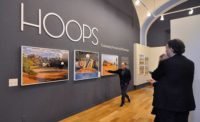I have a tendency, when visiting a museum, to spend a lot of time with the first few of those carefully hand-lettered descriptions of the artist’s or architect’s life, where the crowd tends to gather. I know that some people slip around those crowds, ignoring the gentle babble of audioguides, and walk in to enjoy the visual presentation itself. But I figure that some curator has spent a lot of time on these signs, and I always go into an exhibition wanting to take away every last morsel of knowledge. And then my feet start to hurt. And then my brain starts to hurt. And I realize that if I really want to know everything about Mies van der Rohe or Monet or King Tut, then I’m just going to have to buy the catalog.
It is to the National Building Museum’s credit that when you reach the end of its new interactive exhibit (if you can ever truly reach the end of an online, non-linear exhibit), Building America www.nbm.org, you’re not dumped into the gift shop. But even sitting in a comfortable desk chair, I started to get that same feeling of malaise and ambivalence that comes over me as I rush ahead to the last room of an exhibit to sit down wait for my friends. Building America is, in a way, the Building Museum’s permanent collection, on the web. It’s an effort—a laudable and substantially accomplished effort—to put the history of American construction out in cyberspace, where the general public can get a better idea of its environment. To undertake the effort, the NBM brought on the venerable exhibition designers Ralph Appelbaum Associates, who coordinated with the NBM’s curatorial staff.
The result is a nifty, if cursory little look at American architecture, planning, structural engineering, and landscape design. The site, which has a good deal of animation, without being annoying (no small feat on today’s multimedia-happy Web), is divided into three sections, based on how the content is presented. The first, and most successful of these sections, is a series of interactive timelines, which are further subdivided into four topic areas, and then into specific timelines within those topic areas. For instance, you would click on "Timelines," followed by "House and Home," and then you would have to choose between "Domestic Icons and Innovative Homes" (where you would find the Vanna Venturi House and Fallingwater) and "Where We Live" (which is a more general discussion of housing types). These timelines are deliriously easy to navigate, and they actually do a good job of illuminating concepts that might not be immediately clear. For instance, we discover that the PSFS Building in Philadelphia, which can be found in the "On the Job" timeline within "Commerce and Community," was completed in 1932. I had always admired PSFS, but despite the repeated refrain of "one of the first International Style buildings in the U.S.," I had never quite grasped its temporal importance until I saw that the dot placed in 1931 belonged to the Empire State Building, which I had always mentally placed in a completely different era. My one quibble with the timelines is with some strange choices tacked on at the end. Will the portable skyscraper designed by the firm FTL turn out to be as important as the Larkin Building? Are miniature golf courses as important to U.S. landscape design as Central Park and the National Mall?
But as I said, those are quibbles. Maybe the picture of the windmill keeps the kids quiet while Mom and Dad stroll around the virtual museum.
My usual museum fatigue kicked in when I took a look at the section of the site called "Essays." "Essays" is a stretch as a word to define this section, and much of what is in these sections is repeated from elsewhere in the site. One, a short biography of Frank Lloyd Wright, fares better than the others in terms of depth, but then again, maybe adding knowledge isn’t the point of a site like this one. Maybe the point is to take the knowledge that is already around (and the NBM has collected a pretty good fount of it) and share it with as many people as possible. Building America has at least done that.





